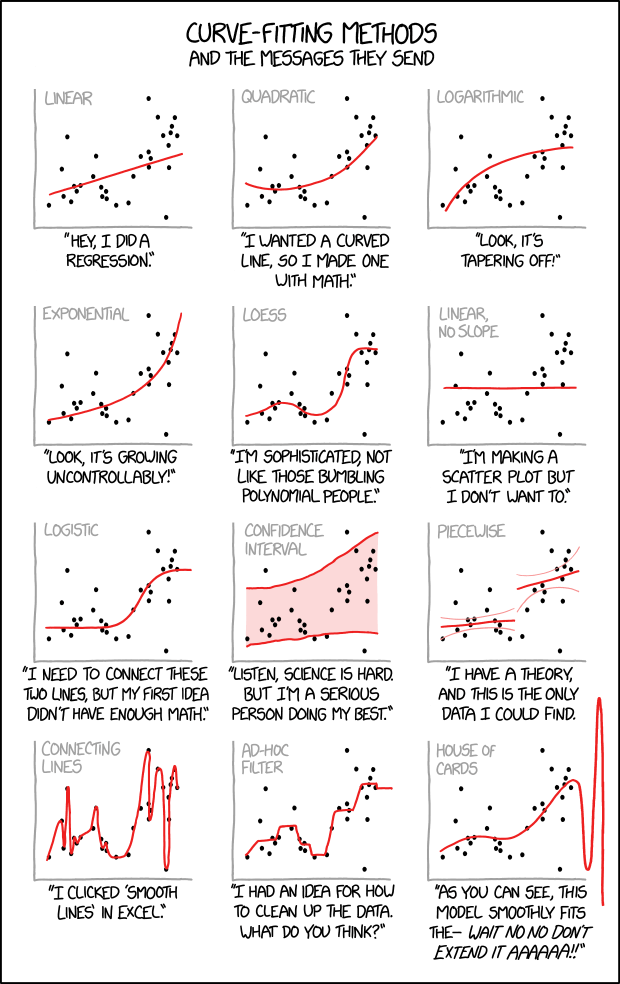Mathematical Foundations of Machine Learning
Prof. Matthieu Bloch
Wednesday, September 18, 2024 (v1.0)
Last time

- Last class: Monday September 16, 2024
- We talked about least square regression
- To be effectively prepared for today's class, you should
have:
- Come to class last week
- Gone over slides and read associated lecture notes
- Logistics
- Office hours
- Jack Hill: 11:30am-12:30pm on Wednesdays in TSRB and hybrid
- Anuvab: 12pm-1pm on Thursdays in TSRB and hybrid
- Gradescope
- Make sure you assign each solution to each question
- Make sure you do some quality control on your submission
- Office hours
Solving the least-squares problem
Any solution \(\bftheta^*\) to the problem \(\min_{\bftheta\in\bbR^d} \norm[2]{\bfy-\matX\bftheta}^2\) must satisfy \[ \matX^\intercal\matX\bftheta^* = \matX^\intercal\vecy \] This system is called normal equations
Facts: for any matrix \(\bfA\in\bbR^{m\times n}\)
\(\ker{\bfA^\intercal\bfA}=\ker{\bfA}\)
\(\text{col}(\bfA^\intercal\bfA)=\text{row}(\bfA)\)
\(\text{row}(\bfA)\) and \(\ker{\bfA}\) are orthogonal complements
We can say a lot more about the normal equations
- There is always a solution
- If \(\textsf{rank}(\bfX)=d\), there is a unique solution: \((\matX^\intercal\matX)^{-1}\matX^\intercal \bfy\)
- if \(\textsf{rank}(\bfX)<d\) there are infinitely many non-trivial solution
- if \(\textsf{rank}(\bfX)=n\), there exists a solution \(\bftheta^*\) for which \(\bfy=\bfX\bftheta^*\)
In machine learning, there are often infinitely many solutions
Minimum norm 2 solutions
Reasonable approach: choose a solution among infinitely many with the minimum energy principle \[ \min_{\bftheta\in\bbR^d}\norm[2]{\bftheta}^2\text{ such that } \bfX^\intercal\bfX\bftheta = \bfX^\intercal\bfy \]
- We will see the solution is always unique using the SVD
For now, assume that \(\textsf{rank}(\bfX)=n\), so that the problem becomes \[ \min_{\bftheta\in\bbR^d}\norm[2]{\bftheta}^2\text{ such that } \bfX\bftheta = \bfy \]
If \(\textsf{rank}(\bfX)=n\) the solution is \(\bftheta^*=\matX^\intercal(\matX\matX^\intercal)^{-1}\bfy\)
Regularization
- Recall the problem \(\min_{\bftheta\in\bbR^d}\norm[2]{\bftheta}^2\)
such that \(\bfX^\intercal\bfX\bftheta =
\bfX^\intercal\bfy\)
- There are infinitely many solution if \(\ker{\bfX}\) is non trivial
- The space of solution is unbounded!
- Even if \(\ker{\bfX}=\set{0}\), the system can be poorly conditioned
- Regularization with \(\lambda>0\) consists in solving \[
\min_{\bftheta\in\bbR^d}\norm[2]{\bfy-\bfX\bftheta}^2 +
\lambda\norm[2]{\bftheta}^2
\]
- This problem always has a unique solution
The solution is \(\bftheta^*=(\bfX^\intercal\bfX+\lambda\bfI)^{-1}\bfX^\intercal\bfy = \bfX^\intercal(\bfX\bfX^\intercal+\lambda\bfI)^{-1}\bfy\)
- Note that \(\bftheta^*\) is in the row space of \(\matX\) \[ \bftheta^* = \matX^\intercal\bfalpha\textsf{ with } \bfalpha =(\bfX\bfX^\intercal+\lambda\bfI)^{-1}\bfy \]
Ridge regression
We can adapt the regularization approach to the situation of a finite dimension Hilbert space \(\calF\) \[ \min_{f\in\calF}\sum_{i=1}^n(y_i-f(\bfx_i))^2 + \lambda\norm[\calF]{f}^2 \]
- We are penalizing the norm of the entire function \(f\)
Using a basis for the space \(\set{\psi_i}_{i=1}^d\) , and constructing \(\boldsymbol{\Psi}\) as earlier, we obtain \[ \min_{\bftheta\in\bbR^d}\norm[2]{\bfy-\boldsymbol{\Psi}\bftheta}^2 + \lambda \bftheta^\intercal\matG\bftheta \] with \(\matG\) the Gram matrix for the basis.
If \(\boldsymbol{\Psi}^\intercal \boldsymbol{\Psi}+\lambda\matG\) is invertible, we find the solution as \[ \bftheta^* = (\boldsymbol{\Psi}^\intercal \boldsymbol{\Psi}+\lambda\matG)^{-1}\boldsymbol{\Psi}^\intercal \bfy \] and we can reconstruct the function as \(f(\bfx) = \sum_{i=1}^d\theta_i^*\psi_{i}(\bfx)\).
If \(\bfG\) is well conditioned, the resulting function is not too sensitive to the choice of the basis
Least-Squares in infinite dimension Hilbert spaces
In \(\bbR^d\), the problem \(\min_{\bftheta\in\bbR^d}\norm[2]{\bfy-\bfX\bftheta}^2 + \lambda\norm[2]{\bftheta}^2\) has a solution
- \(\bftheta^* = \matX^\intercal\bfalpha\) with \(\bfalpha =(\bfX\bfX^\intercal+\lambda\bfI)^{-1}\bfy\)
- \(\matX\matX^\intercal\in\bbR^{n\times n}\) is dimension independent!
- We will be able to extend this to infinite dimensional Hilbert spaces!
Let \(\calF\) be a Hilbert space and let \(f\in\calF\) be the function we are trying to estimate
We will estimate \(f\in\calF\) using noisy observations \(\dotp{f}{x_i}\) with \(\set{x_i}_{i=1}^n\) elements of \(\calF\)
This is the equivalent of saying \(\bfy = \bfA\bfx+\bfn\) in finite dimension
\[ \min_{f\in\calF}\sum_{i=1}^n\abs{y_i-{\dotp{f}{x_i}}_{\calH}}^2+\lambda\norm[\calH]{f} \] has solution \[ f = \sum_{i=1}^n\alpha_i x_i\textsf{ with } \bfalpha = (\matK+\lambda\matI)^{-1}\vecy\qquad \matK=\mat{c}{\dotp{x_i}{x_j}}_{1\leq i,j\leq n} \]
- This happens in Reproducing Kernel Hilber Space (RKHS)
Next time
- Next class: Monday September 23, 2024
- To be effectively prepared for next class, you
should:
- Go over today's slides and read associated lecture notes
- Work on Homework 3 (to be posted soon)
- Optional
- Export slides for next lecture as PDF (be on the lookout for an announcement when they're ready)